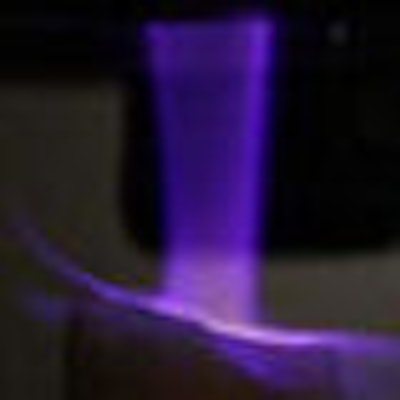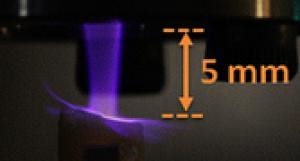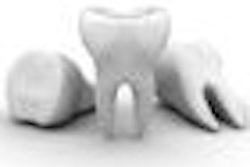
Researchers at the University of Southern California (USC) and Loma Linda University have developed a novel dental probe that uses room-temperature plasma to eliminate biofilms in the oral cavity. And they contend that this nonthermal plasma is safer and more effective than lasers for endodontic disinfection (Plasma Processes and Polymers, April 20, 2009).
“Plasma is the future.”
— Parish Sedghizadeh, D.D.S.,
assistant professor of clinical
dentistry and director of the
USC Center for Biofilms
In preliminary experiments, the plasma probe -- which generates a 2.5-cm long, pencil-like plasma plume -- was used to treat root canals in six ex vivo human teeth, by placing teeth several millimeters below the probe nozzle. Scanning electron microscopy showed complete destruction of endodontic biofilms up to 1 mm inside a root canal after plasma treatment for 5 minutes, and the dental materials remained intact after treatment, according to Chunqi Jiang, a research assistant professor in USC's Ming Hsieh Department of Electrical Engineering-Electrophysics, and colleagues.
"I have been working with plasma devices already -- my dissertation was for pollution control -- and I was thinking about how to generate a plume that could go all the way into the canal to disinfect the bacteria," Jiang told DrBicuspid.com. "The biofilms are different [than other bacteria]. Even the laser technology is not very effective against the biofilms."
Rather than heating the bacteria in an attempt to kill it, the nanosecond pulsed plasma probe's antibacterial effects result from the creation of atomic oxygen -- a single atom of oxygen rather than the more common O2 molecule -- that oxidize the bacteria in the biofilm, according to Jiang and her colleagues.
"The oxygen-free radicals might be disrupting the cellular membranes of the biofilms in order to cause their demise," said Parish Sedghizadeh, D.D.S., an assistant professor of clinical dentistry and director of the USC Center for Biofilms. "The plasma plume's adjustable, fluid reach allowed the disinfection to occur even in the hardest-to-reach areas of the root canal."
 |
| The small plasma probe can destroy biofilm infections, yet is cool and safe to the touch. Image courtesy of the University of Southern California. |
They are now working to better understand the plasma bactericidal mechanisms and develop additional applications for the probe, she added, including treating periodontal disease, caries, and osteonecrosis of the jaw. They are also seeking partners to help develop a commercial version of the device, and estimate that the device would cost "much less" than laser systems because the main component -- the pulse generator -- only costs around $2,000, according to Jiang.
"Plasma is the future," Sedghizadeh said. "It's been used before for other sterilization purposes but not for clinical medical applications, and we hope to be the first to apply it in a clinical setting."
Copyright © 2009 DrBicuspid.com



















